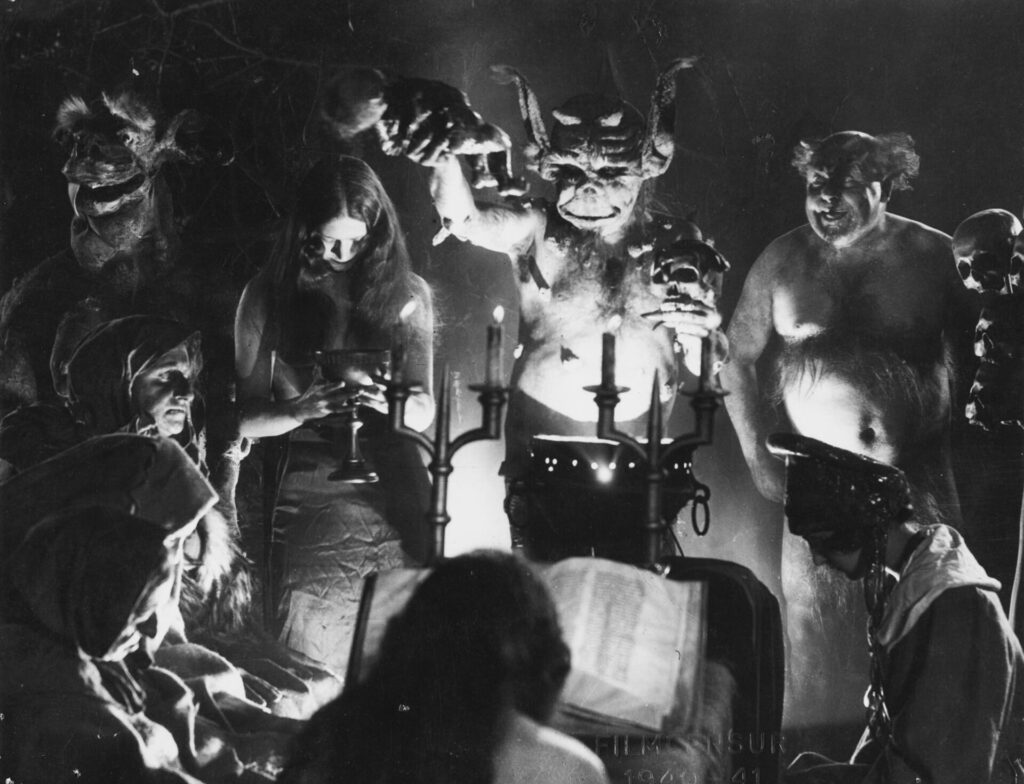A senior curator at the Museum of the Moving Image, Michael Koresky, has teamed up with Oscar-winning filmmaker Jeff Reichert to organize a special film series for the fall season titled **“Dark Magic: Hexes and Haunts for Halloween.”** This program coincides with the publication of a compendium of essays sourced from *Reverse Shot*, an online magazine affiliated with the museum. Koresky and Reichert promise that New Yorkers will be suitably “ensorcelled” by their intriguing curatorial choices.
The emphasis of this nine-film series at MoMI is on incantations of a nefarious sort. Fans of cinematic witchery may find themselves lamenting the absence of some personal favorites—mine would be Carl Dreyer’s brutal *Days of Wrath* (1943) and Michael Reeves’s *Witchfinder General* (1968), featuring a flinty performance by Vincent Price. Still, *Dark Magic* is brimming with curiosities; sometimes, you can’t always have your bubbling cauldron and sup from it, too.
### Häxan (1922)
The earliest film in the lineup is Benjamin Christensen’s *Häxan* (1922), a picture that should captivate anyone who delights in the blurry lines between fact and fiction. This Swedish production, helmed by a Danish director, explores all things supernatural through a didactic lens, posing as an academic lecture presented in discrete chapters.
When made, *Häxan* was the most expensive Danish film ever produced and was considered “absolutely unfit for public consumption” by *Variety*. Even today, the film remains remarkably lurid and often disturbing. The evolution of the horror genre is unimaginable without this groundbreaking work.
Christensen drew inspiration from painters like Bosch, Bruegel, and Goya for the film’s various mise-en-scènes, employing stop-motion animation, puppetry, and optical effects to impressive and gritty effect, despite their relative crudity. Johan Ankerstjerne’s brooding cinematography and Richard Louw’s clever art direction lend an uncanny veracity to scenes that might otherwise risk being laughable.
Adding to the haunting experience, pianist Makia Matsumura will provide an eerie live accompaniment during the screenings at MoMI.
### Cat People (1942)
Jacques Tourneur’s *Cat People* (1942) set a high cinematic standard for B-movies that defied their modest budgets. RKO Studios tasked producer Val Lewton with creating low-cost horror films, giving him evocative titles to work with. Lewton’s creativity, combined with a talented team, concluded in a sinister tale of “those who slink and court and kill at night.”
Initially skeptical, the RKO executives were silenced when *Cat People* became a smash hit. Clocking in at just an hour and fifteen minutes, the film is set on a Hollywood backlot masquerading as New York City.
The story follows Irena Dubrovna (Simone Simon), a Serbian immigrant who fears she is cursed to transform into a panther when sexually aroused. This curse threatens her marriage to Oliver (Kent Smith), especially when he grows close to his co-worker Alice (Jane Randolph). Throughout, Tourneur maintains a tight grip on mood and atmosphere, evoking a sense of isolation and tension.
### Onibaba (1964)
Arguably the most profound film in the series is Kaneto Shindo’s *Onibaba* (1964). Historians, critics, and film enthusiasts often debate how best to categorize this sparse yet powerful story of war, famine, sex, and retribution.
Set in 14th-century Japan, *Onibaba* follows a nameless mother and her daughter-in-law (played by Nobuko Otowa and Jitsuko Yoshimura, respectively) as they survive in a war-torn countryside by killing stray soldiers, disposing of their bodies, and selling their armor on the black market to a local dealer, Ushi (Taiji Tonoyama).
Their grim routine is disrupted when a deserter named Hachi (Kei Satō) arrives. The daughter-in-law becomes involved with Hachi, sparking tension and jealousy from the mother. Things spiral when the mother acquires an elaborately stylized mask from a recent victim, using it to intimidate her daughter. However, the mask carries unexpected—and catastrophic—consequences.
*Onibaba* is based on a Buddhist fable about hubris and deceit, and Shindo’s film carries multiple layers of meaning. Otowa’s fierce performance as the ruthless mother is especially intense, while the film’s atmosphere is thick with sweat, desperation, and dread.
The overall tone is dour, reflecting the lingering trauma of the atomic bombings of Hiroshima and Nagasaki—a subtext the director intentionally weaves into the film.
By turns poetic, erotic, horrific, and philosophical, *Onibaba* reveals much more than its barebones narrative suggests, making it a must-see in the *Dark Magic* series.
—
The **“Dark Magic: Hexes and Haunts for Halloween”** program promises a rich selection of films that delve into the supernatural, the eerie, and the unsettling. Whether you are a casual fan or a devoted cinephile, this series offers an opportunity to explore the darker corners of cinema history through expertly curated gems.
For more information and ticketing, visit the Museum of the Moving Image website.
https://www.nysun.com/article/for-halloween-the-museum-of-the-moving-images-offers-nine-films-featuring-dark-magic

